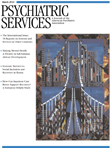Letter
Cervical Cancer Screening of Women With Schizophrenia in Taiwan
To the Editor: Numerous studies have demonstrated that regular Pap smear testing has significantly reduced cervical cancer incidence and mortality over the past 30 years. However, the rate of testing is still low. In particular, research has shown that women with mental illness are less likely than the general population to have Pap smears, because they are not aware of the importance of such screening or because treatment facilities are not easily accessible. However, almost all such studies have focused on patients with depression, anxiety, or intellectual disabilities ( 1 , 2 , 3 ), and very few have explored the rate of Pap smear testing among patients with schizophrenia ( 4 ). In addition, data are lacking from Asian populations. Therefore, this study aimed to examine the screening rate among patients with and without schizophrenia in Taiwan.
Data were from the Longitudinal Health Insurance Database (LHID). All female patients who visited ambulatory care centers in 2003 and received a principal diagnosis of schizophrenia (any ICD-9-CM 295 code other than 295.7, schizoaffective disorder) were eligible for the study (N=1,690). Because the diagnostic validity of administrative data is often questioned, only patients who had at least two consensus schizophrenia diagnoses three months apart in 2003 were included (N=1,504). We excluded patients under 30 years of age (N=273) because the National Health Insurance (NHI) program provides an annual free cervical cancer screen only for women aged 30 and older. We also excluded patients over age 69 (N=54) and patients given a diagnosis of cervical cancer between 1996 and 2006 (N=2). The final sample included 1,175 female patients with schizophrenia. We then randomly selected 9,400 persons (eight for every patient in the study group) who were matched in age (30–39, 40–49, 50–59, and 60–69 years) from other patients in the 2003 LHID Registry of Beneficiaries. Conditional logistic regression analysis, which was conditioned on age, was conducted to evaluate the association between a diagnosis of schizophrenia and the likelihood of receiving at least one Pap smear test during the three-year period (2004–2006).
Of the total sample of 10,575 patients, 5,552 (52.5%) received a Pap test during the three-year period—403 of the patients with schizophrenia (34.3%) and 5,149 of the patients in the comparison group (54.8%). Conditional logistic regression analysis showed that patients with schizophrenia were significantly less likely than those in the comparison group to receive a Pap smear test (odds ratio=.35, 95% confidence interval=.30–.40, p<.001), after adjustment for age, monthly income, number of ambulatory care visits, and level of urbanization and geographic location of the community in which the patient resided.
Our study found that even with the NHI program, which provides free annual screening for cervical cancer, women with schizophrenia were significantly less likely than women without schizophrenia to receive Pap smear tests. These findings suggest a need for more active intervention and comprehensive strategies to increase screening rates among women with schizophrenia.
Acknowledgments and disclosures
This study is based in part on data from the National Health Insurance Research Database provided by the Bureau of National Health Insurance, Department of Health, Taiwan, and managed by the National Health Research Institutes. The interpretations and conclusions do not represent those of the Bureau of National Health Insurance, Department of Health, or the National Health Research Institutes.
The authors report no competing interests.
1. Pirraglia PA, Sanyal P, Singer DE, et al: Depressive symptom burden as a barrier to screening for breast and cervical cancers. Journal of Women's Health 13:731–738, 2004Google Scholar
2. Wilkinson JE, Cerreto MC: Primary care for women with intellectual disabilities. Journal of the American Board of Family Medicine 21:215–222, 2008Google Scholar
3. Owen C, Jessie D, De Vries Robbe M: Barriers to cancer screening amongst women with mental health problems. Health Care for Women International 23:561–566, 2002Google Scholar
4. Martens PJ, Chochinov HM, Prior HJ, et al: Are cervical cancer screening rates different for women with schizophrenia? A Manitoba population-based study. Schizophrenia Research 113:101–106, 2009Google Scholar



